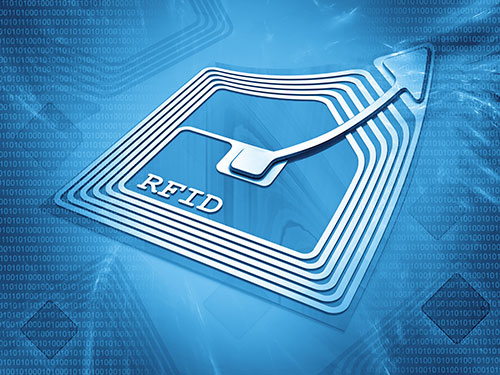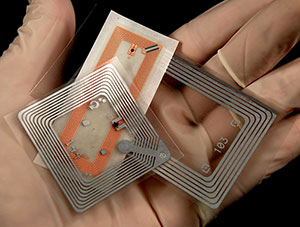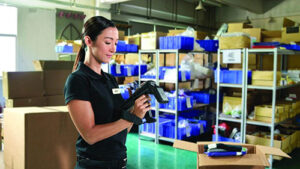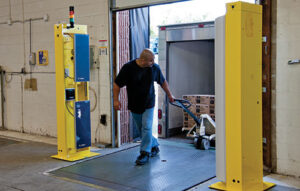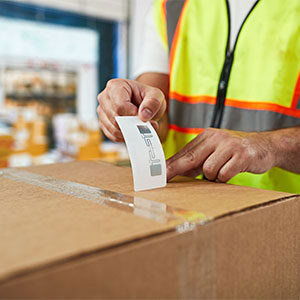What is RFID? Radio-frequency identification (RFID), is a technology like barcoding. But RFID is able to store much more information than traditional barcodes. RFID applications use radio waves to automatically identify people or objects.
Does putting data into computers with little human intervention sounds appealing? If so, radio-frequency identification may be for you.
So how does RFID work? Let’s take a crash course and find out.
RFID 101
Parts of an RFID System
RFID is a system consisting of a tag or smart label, a reader, also called an interrogator, and an antenna. The tag contains a circuit and an antenna, which transfers information to the reader.
Then the reader converts the information to a more usable form of data. In turn, this information is then transferred to a computer database with a software.
Types of RFID Tags
There are two types of RFID tags: active and passive. Active RFID tags have a transmitter and a power source, typically a battery, to broadcast a signal to a reader.
In contrast, passive RFID tags do not have a battery. Instead, they draw power from the reader. Also, semi-passive tags use a battery to power the chip, but communicate by drawing power from the reader.
Active tags have a longer read range than passive tags. Active tags can be read from a distance of 1,500 feet away, or more.
Benefits of RFID
Now that we know how RFID systems work, let’s talk about why your company would want to use an RFID system. In the fast-moving consumer goods industry, your company needs to be just that, fast.
Many manufacturers need to count products several times during the span of one day. RFID allows you to complete product counts in seconds. This decreases the amount of manual work, and in turn, reduces costs.
Also, RFID scanners do not have to be in the line of sight of the tag, and the scanners can also read more than one tag at a time. RFID may be useful in supply chain management through inventory control or asset tracking in manufacturing or warehouse environments.
As we mentioned, RFID systems are able to contain much more information than a bar code. For example:
- Real-time movement of products
- Amount of time needed for production
- Which machines have and haven’t gone under maintenance
Some more benefits of an RFID system include:
- Accuracy
- Efficiency
- Quickening of the manufacturing process
- Greater visibility
- Improved planning
Disadvantages of RFID
Although RFID has many pros, it also comes with some cons. Some of these include:
- Limitations of type of materials
- Cost of development can be high
- Incompatible standards across tag type, industries, and different countries
A critical element of the RFID system is the middleware (software)
Middleware aggregates, manipulates, and analyzes tag data. Without software, you’re just reading tags, not putting that data to use!
Thinking that RFID might be a good fit for your business? Get started by reading through the FAQs below.
RFID FAQs
What is Automatic Identification?
Automatic identification, is the broad term given to a host of technologies. These tech systems help machines identify objects.
For example, bar code data collection, and voice recognition are just a few of these systems. Also, some biometric technologies, optical character recognition, and RFID all fall under the umbrella of automatic identification.
How does RFID work?
An RFID system consists of a tag or RFID label, an interrogator or reader, and an antenna. The reader sends out electromagnetic waves to transmit data. The tag includes an antenna tuned to receive these waves.
The chip and the antenna together are called an RFID transponder or an RFID tag. This is where the communication begins.
First, tags works by transmitting identification information to RFID readers as radio waves. Then the reader converts the radio waves to digital information. Finally, the information passes on to applications that can make use of it in real-time.
The most common method of unique identification is by serial number. This serial number is on a microchip attached to an antenna. It is then used to identify a person, object or information. For instance, this information could be an individual item’s electronic product code.
Is RFID better than using barcodes?
RFID is not “better” than bar codes. The two are different technologies and have different applications, which sometimes overlap.
The big difference between the two is bar codes are line-of-sight technology. In contrast, radio frequency identification, doesn’t need line of sight.
What’s the difference between passive and active tags?
Active RFID tags have a battery. This runs the microchip’s circuitry and broadcasts a signal to a reader.
Passive tags have no battery. They draw power from the reader, which sends out electromagnetic waves. These waves induce a current in the tag’s antenna.
Semi-passive tags use a battery to run the chip’s circuitry. But they communicate by drawing power from the reader.
How much information can the tag store?
It depends on the vendor and the application. Typically, a tag would carry no more than 2KB of data—enough to store some basic information about the item it is on. Companies are now looking at using a simple “license plate” tag. These tags contain only a 96-bit serial number.
What’s the difference between read-only and read-write tags?
Microchips in RFID tags can be read-write or read-only. With read-write chips, you can add information or write over existing information. This happens when the tag is within range of a reader, or interrogator.
Read-write tags usually have a serial number that can’t be written over. More blocks of data can store extra information about the tagged items.
What is reader collision?
A signal from one reader can interfere with the signal from another where coverage overlaps. This is reader collision. One way to avoid the problem is to use a technique called time division multiple access, or TDMA. In simple terms, the readers read at different times, rather than both trying to read at the same time.
What is tag collision?
Tag collision occurs when more than one chip reflects back a signal at the same time. This confuses the reader.
What is the read range for a typical RFID tag?
In general, read range for low-frequency tags is a foot or less. In contrast, it’s about three feet for high frequency tags, and UHF tags from 10 to 20 feet.
Where there is a need for longer ranges, active tags use batteries to boost read ranges to 300 feet or more. For example, this is necessary for for tracking railway cars.
What are some of the most common applications for RFID?
The most common applications are tracking goods in the supply chain. Another use is to keep track of reusable containers, high value tools and other assets. Also, it can be used to track parts moving to a manufacturing production line.
Knowledge is key to any software implementation, so you have realistic expectations of what you can achieve. So, before seeking out a vendor, be sure to educate yourself and your project team.
Remember to evaluate all the components to a successful RFID Solution. This includes not only tags and readers, but middleware as well. Without the software you’re just scanning tags!
What Are Your RFID FAQs?
Your success starts with realistic goals, a committed team and knowledgeable RFID vendor. With this in mind, incorporating RFID technology can benefit your business. Are you still wondering what is RFID and how can it work for your company? Ask a Radley product specialist for the answers!

